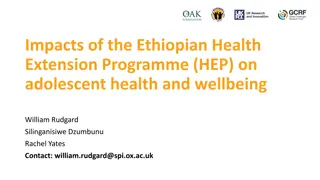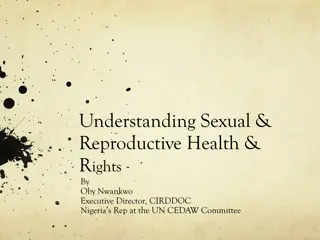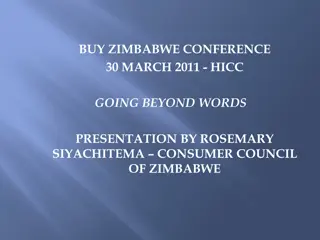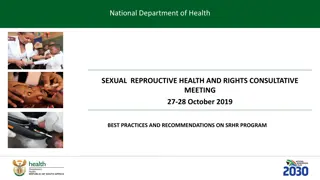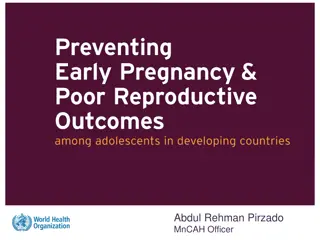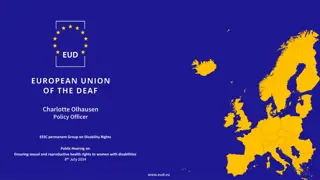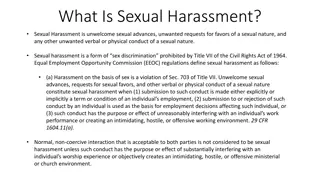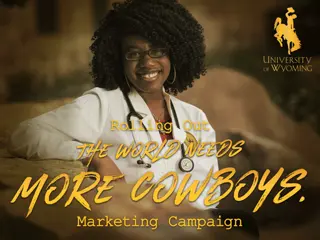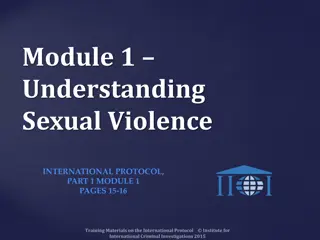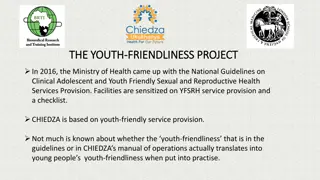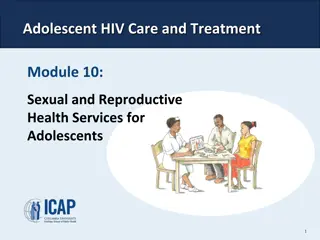Enhancing Adolescent Sexual and Reproductive Health Rights in Zimbabwe: 2021-2022 Campaign
This campaign focuses on improving access to sexual and reproductive health services for adolescents in Zimbabwe through policy analysis, normative frameworks alignment, and targeted actions such as provision of menstrual ware and comprehensive sexuality education. Emphasis is placed on fulfilling Sustainable Development Goals, international commitments, and regional protocols to ensure equal access and rights for young people.
Download Presentation

Please find below an Image/Link to download the presentation.
The content on the website is provided AS IS for your information and personal use only. It may not be sold, licensed, or shared on other websites without obtaining consent from the author.If you encounter any issues during the download, it is possible that the publisher has removed the file from their server.
You are allowed to download the files provided on this website for personal or commercial use, subject to the condition that they are used lawfully. All files are the property of their respective owners.
The content on the website is provided AS IS for your information and personal use only. It may not be sold, licensed, or shared on other websites without obtaining consent from the author.
E N D
Presentation Transcript
Zimbabwe Alliance ASRHR Campaign 2021-2022
What this will cover Situation analysis SWOT Key actors Key targets Objectives Messages Action plan short term Action plan long term
Situation analysis Indicators Existence of stand alone ASRHR policies/guidelines Zimbabwe Yes Existence of laws and policies that allow adolescents to access SRH services without third party authorization No Provision of free menstrual ware Removal of Value Added Tax (VAT) on menstrual ware CSE curriculum reflects international standards Age of access to contraceptives Legal age to consent to sex (M) Legal age to consent to sex (F) Adolescent fertility rate (per 1000 women, 15-19 years of age) Adolescent birth rate (births per 1000 women, 15-19 years of age by %) No Yes Partial 16 16 16 86 108
Normative frameworks Sustainable Development Goal (SDG)-4: Ensure inclusive and equitable quality education and promote lifelong learning opportunities for all. SDG 5.6.2measures the number of countries with laws and regulations that guarantee full and equal access to women and men aged 15 years and older to sexual and reproductive health care, information and education. International Conference on Population and Development (ICPD)paragraphs 4.29, 7.37, 7.41, and 7.47: Sexuality education to promote the well-being of adolescents specifies key features of such education. Education should take place both in schools and at the community level, be age-appropriate, begin as early as possible, foster mature decision-making, and specifically aim to improve gender inequality. Such programmes should address specific topics, including gender relations and equality, violence against adolescents, responsible sexual behaviour, contraception, family life and sexually transmitted infections (STIs), HIV and AIDS prevention. The East and Southern Africa (ESA) Ministerial Commitment: 15 SADC countries signed the Commitment, which 20 countries endorsed and affirmed in 2013 (the ESA-CSE commitment). Education and health ministers from these countries committed to accelerate access to CSE and health services for young people in the region. Comoros is the only SADC country that is not part of this commitment. SADC Gender Protocol Article 11: Ensure that the girl and the boy child have equal access to information, education, services and facilities on sexual and reproductive health and rights. Adopt laws, policies, and programmes to ensure the development and protection of the girl and the boy child. The SADC SRHR Strategyfor ensuring CSE notes that member states should accelerate and improve delivery of quality comprehensive sexuality education for in and out of school youth by the education and youth sectors.
Normative frameworks (cont) Article 26 (c) SADC Gender Protocol: Ensure the provision of hygiene and sanitary facilities and nutritional needs of women, including women in prison. SDG 3.7: By 2030, ensure universal access to sexual and reproductive healthcare services, including for family planning, information and education, and the integration of reproductive health into national strategies and programmes. SDG 3.1: By 2030, Reduce maternal mortality to fewer than 70 deaths per 100 000 live births Maputo Protocol Article 14.1: Ensure that the right to health of women, including sexual and reproductive health is respected and promoted. This includes: a) The right to control their fertility; b) The right to decide whether to have children, the number of children and the spacing of children; and c) The right to choose any method of contraception.
Current situation Is there a desire to update the National Adolescent Sexual and Reproductive Health Strategy 2016- 2020? What existing policies are there that need to be cross referenced? Do these cover all the issues in the Alliance ASRHR checklist? What are the main gaps to be covered in the updated ASRHR strategy?
SWOT STRENGTHS WEAKNESSES THREATS OPPORTUNITIES The current national adolescent sexual and reproductive health strategy have been working from previous years to protect the safety of Girls. Protecting girls from sexual abuses. The age of consent fighting against child There is a bridge between what the bill says and what is on the ground. Children below 18 cannot consent, but children aged 16 can be sexually engaged . Culture is a major backdrop in terms of children who are sexually active in They is confusion which is caused by the age of consent and the age for statutory rape . Cultural norms are continuing being rigid causing children to get more exposed to unwanted teen ^pregnancy SRHR services are not being friendly Engaging policy makers Awareness raising to adolescent girls so they can access SRHR services Access to information and sexual health services to people with disability
Key actors and partners The ministry of health and child care Civil society organisations Parliament Churches Ministry of primary and secondary education.
Objectives To facilitate access to SRHR services for Adolescent girls according to the current laws and policies . To advocate for broadening of policy review in accessing SRHR services . (persons with Disability) To address barriers girls face in accessing services .
Action plan - short term ACTION WHO WHEN -Awareness campaigns on SRHR in all areas (urban and rural) WROs Immediate -Advocate for youth friendly SRHR services WROs Nov 2021 -Lobby for the opening up of services by Council clinics WROs Oct 2021 -Follow up with the government on the provision of free sanitary pads and advocating for reduction of pads price/tax WROs Immediate
Action plan - short term ACTION WHO WHEN Advocate for accessible and affordable health services WROs Immediate
Action plan - long term ACTION WHO WHEN -Advocate for review of National Adolescent Sexual and Reproductive Health Strategy 2016-2020 WROs Nov 2021 Advocate for increased budget for health services (Abuja declaration 15%) CSOs Oct 2021







